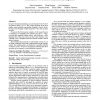PADL
2007
Springer
14 years 11 months ago
2007
Springer
Essential elements of aspect-oriented programming can be formulated as forms of logic programming. Extensions of Horn Clause rovide richer abstraction and control mechanisms. Defi...
ICWE
2007
Springer
14 years 11 months ago
2007
Springer
Abstract. It is more convenient to talk about changes in a domainspecific way than to formulate them at the programming construct level or—even worse—purely lexical level. Usi...
TOOLS
2008
IEEE
14 years 11 months ago
2008
IEEE
Abstract. Design patterns provide solutions to recurring design problems in object-oriented programming. Design patterns typically crosscut class boundaries so previous work aimed ...
KBSE
2008
IEEE
14 years 11 months ago
2008
IEEE
—In spite of the modularization benefits supported by the Aspect-Oriented programming paradigm, different usability issues have hindered its adoption. The decoupling between asp...
FOAL
2009
ACM
14 years 11 months ago
2009
ACM
Aspect-oriented programming (AOP) promises to localize concerns that inherently crosscut the primary structural decomposition of a software system. Localization of concerns is cri...
ICST
2009
IEEE
14 years 11 months ago
2009
IEEE
Aspect-oriented programming (AOP) languages introduce new constructs that can lead to new types of faults, which must be targeted by testing techniques. In particular, AOP languag...
ICSM
2009
IEEE
14 years 11 months ago
2009
IEEE
Back in 2001, the MIT announced aspect-oriented programming as a key technology in the next 10 years. Nowadays, 8 years later, AOP is not widely adopted. Several reasons can expla...
SAC
2009
ACM
14 years 11 months ago
2009
ACM
Ubiquitous computing and service-oriented computing enable the development of a new trend of applications that can opportunely interact with services discovered in the surrounding...
AOSD
2010
ACM
14 years 11 months ago
2010
ACM
Statically typed aspect-oriented programming languages restrict application of around advice only to the join points that have conforming types. Though the restriction guarantees ...
119
click to vote
POPL
2007
ACM
15 years 5 months ago
2007
ACM
In aspect-oriented programming, one can intercept events by writing patterns called pointcuts. The pointcut language of the most popular aspect-oriented programming language, Aspe...




